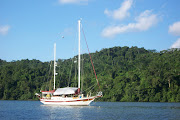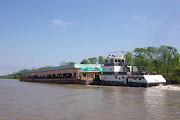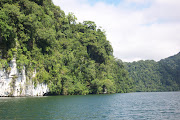 Finally, the forecast wasn't perfect but it wasn't horrible either. The big seas had kept us from exiting the cuts from Spanish Wells and even more importantly, getting in the cuts once we arrived in the Abacos. We didn't want to arrive and then find out we had no place to go. There are two options when heading north toward Little Harbor. One is to go west past Royal Island and exit at Little Egg Island or Southwest Reef. This would add hours to our trip. The other option is to exit through the reef at Ridley Head just north of Spanish Wells. This route takes you toward the dreaded Devils Backbone and requires going between a series of reefs until reaching the deeper waters of Northeast Providence Channel. The ferry ride to Harbour Island gave us a good look at this route and it appeared to be very doable under the right conditions. This was the route we decided to take. When departure day came, there were five other trawlers beside Beach House that planned to make the crossing. We all paid our marina bills, cast off our lines at 8:40 am and headed out. BUT, no one wanted to be the first to go out across the reef. The morning was overcast, causing even more anxiety because visibility would not be good. We planned to use this exit anyway, so it didn't matter to us who went first, so of course, we did. The rest of the boats followed us out. Using our charts, shoreside points and good eyeball navigation, we rounded Ridley Head, lined up the ramp on shore and headed out through the reef - with five other boats behind us hoping we knew what we were doing. The reefs are wider apart than they appear on the charts and we took our time. In short order, the depth sounder was dropping to 25 feet, then 30 feet and then we were soon off soundings. I love it when a plan comes together.
Finally, the forecast wasn't perfect but it wasn't horrible either. The big seas had kept us from exiting the cuts from Spanish Wells and even more importantly, getting in the cuts once we arrived in the Abacos. We didn't want to arrive and then find out we had no place to go. There are two options when heading north toward Little Harbor. One is to go west past Royal Island and exit at Little Egg Island or Southwest Reef. This would add hours to our trip. The other option is to exit through the reef at Ridley Head just north of Spanish Wells. This route takes you toward the dreaded Devils Backbone and requires going between a series of reefs until reaching the deeper waters of Northeast Providence Channel. The ferry ride to Harbour Island gave us a good look at this route and it appeared to be very doable under the right conditions. This was the route we decided to take. When departure day came, there were five other trawlers beside Beach House that planned to make the crossing. We all paid our marina bills, cast off our lines at 8:40 am and headed out. BUT, no one wanted to be the first to go out across the reef. The morning was overcast, causing even more anxiety because visibility would not be good. We planned to use this exit anyway, so it didn't matter to us who went first, so of course, we did. The rest of the boats followed us out. Using our charts, shoreside points and good eyeball navigation, we rounded Ridley Head, lined up the ramp on shore and headed out through the reef - with five other boats behind us hoping we knew what we were doing. The reefs are wider apart than they appear on the charts and we took our time. In short order, the depth sounder was dropping to 25 feet, then 30 feet and then we were soon off soundings. I love it when a plan comes together.This didn't turn out to be one of our better crossings. The 2- to 3-foot swells turned out to be more like 5-foot easterly swells with a 3-foot wind wave coming from the south. These bigger easterly swells were right on our beam and made for a very, very rolly and uncomfortable ride for the next seven hours. We surfed down some of the swells and then came to a screeching halt in the troughs. These conditions were not made for small trawlers, but we were committed and there was no turning back. It actually was lighter at first and built as the day progressed. All of the other boats but one traveled faster than we did, and we soon watched as they disappeared over the horizon. As we approached the Abacos, the big swells moved more aft, but it still was pretty uncomfortable as we surfed down the face of the swells and watched the speed reach almost 10 knots. It was a fine sight as the cut at Little Harbor appeared in front of us, but it wasn't over yet. As we altered course to enter the cut, the swells and wind waves were directly on our beam, and the last five miles were even more uncomfortable. But then we broke through the cut, and other than some following surge working in, it suddenly became so much calmer.
Plan A was to go into Little Harbor and pick up a mooring or find a spot to anchor. Listening to other boats ahead of us, we had the impression that all of the moorings were full. We were unable to raise anyone in Little Harbor on the radio - not Pete's Pub or any of the boats inside the harbor. The entrance channel is 3 feet at low tide and the tide was falling. We didn't want to try and get in, find no space and not be able to get out. The harbor is fairly small. So we moved on to Plan B. On previous visits, we had spent time anchored behind Lynyard Cay and knew the holding was good and the surge almost non-existent. So off we went with one other boat following us. At 4:00 pm, we dropped the hook behind Lynyard Cay just off a small beach near the north end and breathed a major sigh of relief. It had been a long day, and if we had known the conditions we would encounter, we may have delayed the crossing for another day to let the seas subside. But now that we were here, we were happy to finally put the crossing behind us.
 The next morning we dinghied in to Little Harbour. This was the long time home of the artist and sculptor, Randolph Johnston, world renowned for his sculptures in brass and bronze. His son Peter now carries on the tradition, and the family foundry, as well as a gallery, are two of the main attractions. And don't forget Pete's Pub. We visited the gallery, had a great lunch at Pete's Pub and walked over to the Atlantic side to watch the surf break on the rocks. Little Harbour is a very picturesque location, but things to do are limited. There is now a charge to visit the foundry. The last time we were here, you could just walk in and watch them work. One can still see the caves in the rocks, located at the southwest end of the harbor, where the Johnston family lived when they first arrived in the Bahamas. It can all be done in one day, so we decided to move a little farther north and find another anchorage to put us closer to Marsh Harbour, our next major destination.
The next morning we dinghied in to Little Harbour. This was the long time home of the artist and sculptor, Randolph Johnston, world renowned for his sculptures in brass and bronze. His son Peter now carries on the tradition, and the family foundry, as well as a gallery, are two of the main attractions. And don't forget Pete's Pub. We visited the gallery, had a great lunch at Pete's Pub and walked over to the Atlantic side to watch the surf break on the rocks. Little Harbour is a very picturesque location, but things to do are limited. There is now a charge to visit the foundry. The last time we were here, you could just walk in and watch them work. One can still see the caves in the rocks, located at the southwest end of the harbor, where the Johnston family lived when they first arrived in the Bahamas. It can all be done in one day, so we decided to move a little farther north and find another anchorage to put us closer to Marsh Harbour, our next major destination.On our last trip through the Abacos we sped through without spending much time. Because we are still working on our anchorage book for the Bahamas and we had missed so much the last time, our plans were to stay in the Abacos for about a month and visit as many places as time would allow. At 2:30 in the afternoon, we pulled up anchor at Lynyard Cay and moved about 13 miles to Tilloo Cay. We arrived at about 4:00 pm and got a big surprise. As we reached the spot where we planned to anchor, the windlass decided to quit working. Hitting the up or down switched resulted in nothing. We carry a second lightweight Fortress anchor, complete with rode and chain, so we dropped the Fortress, figuring that if we had to retrieve it by hand, it wouldn't be as much effort as our heavier Manson Supreme. The anchor went down and we used our standard anchoring practice of paying out at least 7 to 1 scope and then backing down on the anchor to set it. As we backed down, the anchor just dragged across the bottom. The anchor and rode were hauled back up by hand and we tried again with the same results. The concern now was that for some reason the Fortress wasn't setting, so that only left using the heavier anchor and rode. Well, that didn't set either. Up it all came again, this time with a whole lot more effort. The bottom appeared to be a thin layer of sand over hard rock, making it almost impossible to get a good set. We moved to a different location hoping to find better holding. Down went the anchor and rode, and with the boat in reverse, we were still dragging. As we dropped back, we continued to let out more rode. Suddenly, and much to our delight, the anchor grabbed and seemed to be holding. The winds were forecast to be light overnight, so we settled back and took in the new location.
The evening went without incident and we had a good night's sleep. The next morning, the winds were to start building so we wanted to get to Marsh Harbour early. At just after 9:00 am, we pulled up our well-set anchor and headed for Marsh Harbour. The trip took about two hours, and the winds were at 15 to 20 knots by the time we arrived. We followed a catamaran into the harbor that had been in Marathon while we were there. The harbor was getting full, but there was still plenty of room. We found a nice open spot just below the BTC tower and near the public dinghy dock. This time the anchor set quickly and the first time. The windlass was still not working so one of the first orders of business would be to find someone to make the repairs. Marsh Harbour is considered the hub of the Abacos and is a major provisioning, supply and, most importantly, repair spot for boats spending time in the Abacos or heading back to the U.S. We were confident we could get the work done and be back in business in short order. In the meantime, the only other thing that needed to be done was relax and enjoy just being here.

.jpg)

.jpg)









Capt Chuck,
ReplyDeleteWhen you anchored, did you ever use two anchors? If So, Did you tie both off the Bow or set a stern anchor?
Love the blog!
Jeff, We did not use two anchors at any time during this trip. There are times when it's useful but it's usually a pain and we don't find it beneficial. Any time we have used two anchors it has always been off the bow. The only time we ever used stern anchors was along the Gulf IWW when we wanted to keep the stern out of the channel. It only held the stern in and was not really used as an anchor.
Delete